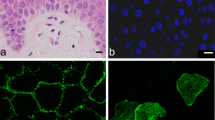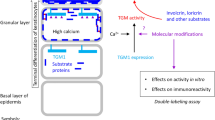Summary
A recently described endogenous proteolytic process in pieces of human plantar stratum corneum incubated in vitro has been further studied. This process leads to a decrease in cohesion between the cells that had been facing outwards in vivo. Using two methods, that differed with respect to efficiency, to detach surface cells with decreased cohesion, the process could be divided into two steps. The first step took place irrespective of the presence of ethylenediaminetetraacetate (EDTA) and led to a moderate decrease in cohesion between surface cells. The second step occurred only in the presence of EDTA and advanced to a point where the surface cells could be separated from the remaining cohesive tissue pieces by simple agitation. Both degradation steps could be inhibited by aprotinin and chymostatin but not by leupeptin. Zinc sulfate inhibited the first step. The results indicate that there are two different types of protein structures being degraded during the process of cell shedding in vitro. A chymotrypsin-like enzyme may be involved in the process.
Similar content being viewed by others
References
Bissett DL, McBride JF, Patrick LF (1987) Role of protein and calcium in stratum corneum cell cohesion. Arch Dermatol Res 279:184–189
Brysk MM, Rajaraman S, Penn P, Chen S-J (1986) Endogenous lectin from terminally differentiated epidermal cells. Differentiation 32:230–237
Brysk MM, Rajaraman S, Penn P, Barlow E (1988) Glycoprotein modulate adhesion in terminally differentiated keratinocytes. Cell Tissue Res 253:657–663
Chen S-J, Rajaraman S, Miller J, Kalmaz GD, Brysk MM (1986) Isolation and characterization of a 30 kDa membrane glycoprotein from human stratum corneum. Biochim Biophys Acta 881:375–382
Edelman GM (1986) Cell adhesion molecules in the regulation of animal form and tissue pattern. Annu Rev Cell Biol 2:81–116
Egelrud T, Lundström A (1989) Immunochemical analysis of the distribution of the desmosomal protein desmoglein I in different layers of plantar epidermis. Acta Derm Venereol (Stockh) 69:470–476
Garrod DR (1986) Desmosomes, cell adhesion molecules and the adhesive properties of cells in tissue. J Cell Sci [Suppl 4]:221–237
Hibino T, Izaki S, Izaki M (1981) Detection of serine proteinase inhibitors in human cornified cells. Biochem Biophys Res Commun 101:948–955
King IA, Tabiowo A, Fryer PR (1987) Evidence that major 78-44-kD concanavalin A-binding glycopolypeptides in pig epidermis arise from the degradation of desmosomal glycoproteins during terminal differentiation. J Cell Biol 105:3053–3063
King IA, Wood MJ, Fryer PR (1989) Desmoglein II-derived glycopeptides in human epidermis. J Invest Dermatol 92:22–26
Laskowski M Jr, Kato I (1980) Protein inhibitors of proteinases. Annu Rev Biochem 49:593–626
Lowry OH, Rosenbrough NJ, Farr AL, Randall RJ (1951) Protein measurement with the Folin phenol reagent. J Biol Chem 193:265–275
Lundström A, Egelrud T (1988) Cell shedding from human plantar skin in vitro: evidence of its dependence on endogenous proteolysis. J Invest Dermatol 91:340–343
Lundström A, Egelrud T (1990) Evidence that cell shedding from plantar stratum corneum in vitro involves endogenous proteolysis of the desmosomal protein desmoglein I. J Invest Dermatol 94:216–220
öbrink B (1986) Epithelial cell adhesion molecules. Exp Cell Res 163:1–21
Takeichi M, Yoshida-Noro C, Shirayoshi Y, Hatta K (1985) Calcium-dependent cell-cell adhesion system: its molecular nature, cell type specificity, and morphogenetic role. In: Edelman GM, Thiery J-P (eds) The cell in contact. Adhesions and junctions as morphogenetic determinants. Wiley, New York Chichester Brisbane Toronto Singapore, pp 219–232
Umezava H (1976) Structures and activities of protease inhibitors of microbial origin. Methods Enzymol 45:678–695
Author information
Authors and Affiliations
Rights and permissions
About this article
Cite this article
Lundström, A., Egelrud, T. Cell shedding from human plantar skin in vitro: evidence that two different types of protein structures are degraded by a chymotrypsin-like enzyme. Arch Dermatol Res 282, 234–237 (1990). https://doi.org/10.1007/BF00371642
Received:
Issue Date:
DOI: https://doi.org/10.1007/BF00371642




